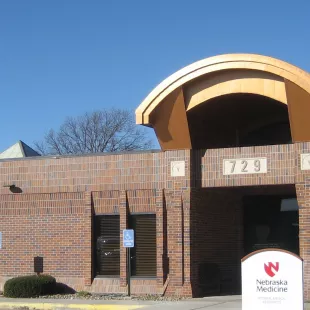Superficial vein thrombosis (SVT) refers to a blood clot in a vein near the surface, deep vein thrombosis (DVT) is a clot in a deep vein in the body, usually in the leg. Superficial vein thrombosis can present as pain and inflammation while deep clots can travel to the lungs and cause a pulmonary embolism. Deep venous thrombosis can cause leg pain and swelling, but in some cases, you may not have any symptoms at all.
Why come to Nebraska Medicine for treatment?
We're Here to Help You Prevent, not Just Cure It
Superficial vein thrombosis risks are age, being overweight, pregnancy, sitting for long periods of time and family history of the condition. Deep vein thrombosis can occur if you are immobile for a long time, such as after surgery or if you are confined to a hospital bed. Our doctors and medical staff are trained to prevent the formation of clots with therapies like medications, compression socks and getting our patients mobile as soon as possible. Treatments depend on your age, health history, current health status, location of the clot and more.
Treatments
- Blood Thinners / Anti-coagulants
- Clot Busters / Thrombolytics
- Interior Vena Cava Filter (IVC)
Prevention
- Anticoagulant medicines are given to certain patients having surgery to prevent blood clots.
- Wiggling the toes and moving the ankles helps to prevent blood clots caused by long periods of sitting or lying down.
- When you travel and must sit for long periods of time, you can reduce your risk of a blood clot by doing the following:
- Walk up and down the aisles (if traveling by plane or bus)
- Stop about every hour and walk a little (if traveling by car)
- While sitting, move your legs, ankles, and toes
- Wear loose clothing
- Limit the amount of alcohol you drink
- Drink a lot of water and other healthy drinks
Prevention may also include:
- Walking. Getting up and moving as soon as possible after surgery or illness
- Sequential compression device (SCD) or intermittent pneumatic compression (IPC). Special sleeves go around both legs. They are attached to a device that applies gentle pressure to the legs. Remove the sleeves so that you do not trip or fall when you are walking, such as when you use the bathroom or shower. Ask for help if you cannot remove and replace the sleeves.
- Elastic or compression stockings, if prescribed by your healthcare provider.
Our Locations
-

-

Vascular Surgery Clinic at Columbus Community Hospital
4600 38th St
Get Directions
Columbus, NE 68601
The vascular services program at Nebraska Medicine is accredited by the Intersocietal Accreditation Commission (IAC).
Nebraska Medicine is a participant in the American College of Surgeons National Surgical Quality Improvement Program® (ACS NSQIP®) is the first nationally validated, risk-adjusted, outcomes-based program to measure and improve the quality of surgical care. ACS NSQIP is designed to help hospitals improve surgical care through the use of risk-adjusted clinical data. The program will place hospitals in the national lead in providing high-quality, effective surgical care.
Nebraska Medicine is a member of the Vascular Quality Initiative (VQI) is a collaborative of regional quality groups collecting and analyzing data in an effort to improve patient care.